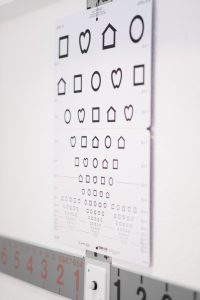Diagnosis, prevention and therapy
Childhood
At birth, our eyes are not yet fully developed.
Glasses may be generally prescribed from the age of two.
A precise diagnosis from an ophthalmologist is recommended to be carried out between the ages of two and four for the following reasons: differences in anatomy or abnormalities of the eyes can lead to different image transfer to the brain. Thus, the brain suppresses the visual impression of one eye, to avoid seeing double images. This leads to weak vision in one eye (amblyopia).
Current ophthalmology now offers effective treatment against amblyopia only in early childhood, best results before the age of 6 years. Often it is sufficient to prescribe a pair of glasses in early childhood and to wear them constantly. Sometimes surgery is necessary, in cases with congenital cataracts, ptosis, or a severe squint. The ophthalmologist recommends the best measures suited to each individual patient.
Teenagers
Sports activities and the desire for a perfect appearance in adolescence often lead to the wish to use contact lenses. When properly used contact lenses are very effective. Due to the general behavior of teenagers good ophthalmic care is especially important when using contact lenses to prevent possible damage to the eyes.
Between the ages of 10 and 22, the most important growth of the body takes place. It is common for the eye to increase its axial length in this period.
This is the reason that many visual aids are needed for the first time at this age, especially for myopic eyes. Adolescence is also responsible to more frequent correction changes.
Adult up to 40
Physical growth is considered complete as of 22 years of age. Frequent changes in the corrective eyewear as seen in the teenage years are observed less often.
Besides glasses and contact lenses, surgical corrections for refraction problems can be considered. This includes laser correction of refractive errors with the excimer laser.
The ideal age for the excimer laser treatment is above 22 if the patient has shown stable correction in the prior three years.
Adults after 40
Statistically, the chances of dangerous eye diseases increases after 40 years of age.
Many dangerous diseases of the eye are not noticed early on in patients as the symptoms may only develop gradually. We therefore recommend that even people without problems get a check from an ophthalmologist every 1 to 2 years.
Old age is often accompanied by internal medical problems (eg diabetes, rheumatism, high blood pressure, etc.) or the use of certain medication that also requires inspections by an ophthalmologist on a regular schedule, to prevent eye damage.


